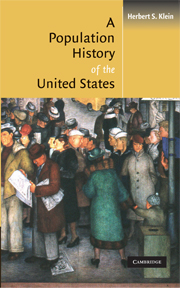Book contents
- Frontmatter
- Contents
- Graphs, Maps, and Tables
- Introduction
- 1 Paleo–Indians, Europeans, and the Settlement of America
- 2 Colonization and Settlement of North America
- 3 The Early Republic to 1860
- 4 The Creation of an Industrial and Urban Society, 1860–1914
- 5 The Evolution of a Modern Population, 1914–1945
- 6 The Baby Boom and Changing Family Values, 1945–1980
- 7 A Modern Industrial Society, 1980–2003
- Appendix: Tables, Graphs, and Maps
- Bibliography
- Index
1 - Paleo–Indians, Europeans, and the Settlement of America
Published online by Cambridge University Press: 05 June 2012
- Frontmatter
- Contents
- Graphs, Maps, and Tables
- Introduction
- 1 Paleo–Indians, Europeans, and the Settlement of America
- 2 Colonization and Settlement of North America
- 3 The Early Republic to 1860
- 4 The Creation of an Industrial and Urban Society, 1860–1914
- 5 The Evolution of a Modern Population, 1914–1945
- 6 The Baby Boom and Changing Family Values, 1945–1980
- 7 A Modern Industrial Society, 1980–2003
- Appendix: Tables, Graphs, and Maps
- Bibliography
- Index
Summary
There is little question that the early demographic history of North America is still one of the most controversial fields in current scholarship. To the older work of archeologists, geologists, and linguists has been added the new work of geneticists and physicists, all of which has often overturned long-established dogmas. The pre-history of North America also remains one of the areas in which all types of enthusiasts have created popular origin myths that still dominate some parts of national thought. In this chapter I will lay out the current state of the debate about the origins of mankind in the Americas and the dating and distribution of the pre-columbian populations over time and space. I will show how this distribution of the American Indian population by 1492 influenced the subsequent European settlement patterns that evolved within the Americas.
The region that today forms the continental boundaries of the United States may have first been settled by humans as early as 30,000 b.p. (or years before the present era), but no later than 15,000 b.p. Homo sapien Neanderthals emerged in eastern Africa some 300,000 to 200,000 years ago. They spread throughout the Euroasian land mass and were slowly replaced by modern Homo sapiens about 40,000 years ago. Given that no Neanderthal remains have been found in the Americas, it is now assumed that human migrations did not occur before this replacement had occurred.
- Type
- Chapter
- Information
- A Population History of the United States , pp. 10 - 36Publisher: Cambridge University PressPrint publication year: 2004

